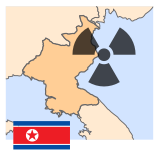
Back Севернокорейски ядрен опит (2013) Bulgarian Prueba nuclear de Corea del Norte de 2013 Spanish آزمایش هستهای کره شمالی (۲۰۱۳) Persian Essai nucléaire nord-coréen du 12 février 2013 French २०१३ के उत्तर कोरियाई परमाणु परीक्षण Hindi Uji coba nuklir Korea Utara 2013 ID Test nucleare nordcoreano del 2013 Italian 北朝鮮の核実験 (2013年) Japanese 2013년 조선민주주의인민공화국 핵 실험 Korean Próba jądrowa w Korei Północnej 12 lutego 2013 roku Polish
| 2013 North Korean nuclear test | |
|---|---|
 USGS infographic on the event | |
| Information | |
| Country | North Korea |
| Test site | 41°18′N 129°05′E / 41.30°N 129.08°E,[1] Punggye-ri Nuclear Test Site, Kilju County |
| Period | 11:57:51, 12 February 2013 KST[1] |
| Number of tests | 1 |
| Test type | Underground |
| Device type | Fission |
| Max. yield |
|
| Test chronology | |
 |
|
On 12 February 2013, North Korean state media announced it had conducted an underground nuclear test, its third in seven years. A tremor that exhibited a nuclear bomb signature with an initial magnitude 4.9 (later revised to 5.1) was detected by the China Earthquake Networks Center,[9] Preparatory Commission for the Comprehensive Nuclear-Test-Ban Treaty Organization[10] and the United States Geological Survey.[1] In response, Japan summoned an emergency United Nations meeting for 12 February and South Korea raised its military alert status. It is not known whether the explosion was nuclear, or a conventional explosion designed to mimic a nuclear blast;[11] as of two days after the blast, Chinese, Japanese, and South Korean investigators had failed to detect any radiation.[12]
- ^ a b c "M5.1 Nuclear Explosion - 24km ENE of Sungjibaegam, North Korea". Earthquake Hazards Program. United States Geological Survey. 12 February 2013. Archived from the original on 13 February 2013. Retrieved 12 February 2013.
- ^ a b "How Powerful Was N.Korea's Nuke Test?". The Chosun Ilbo. 14 February 2013. Archived from the original on 17 February 2013. Retrieved 17 February 2013.
- ^ "Chinese underground nuclear test North Korea reached an unprecedented precision measurement". 19 June 2013. Archived from the original on 21 October 2013. Retrieved 14 July 2013.
- ^ "Russia says no danger to Far East residents over North Korea's nuclear test". Archived from the original on 5 March 2016. Retrieved 23 October 2016.
- ^ Nordkorea: BGR registriert vermutlichen Kernwaffentest - BGR, 6 January 2016
- ^ Nordkorea: BGR registriert vermutlichen Kernwaffentest Archived 16 September 2015 at the Wayback Machine - BGR (In German), 12 February 2013
- ^ "Search Results". USGS.
- ^ "North Korea's Punggye-ri Nuclear Test Site: Analysis Reveals Its Potential for Additional Testing with Significantly Higher Yields". 38North. 10 March 2017.
- ^ "朝鲜(疑爆)Ms4.9地震" (in Chinese). Archived from the original on 9 August 2014.
- ^ "Press Release: On the CTBTO's detection in North Korea". CTBTO. Archived from the original on 15 February 2013. Retrieved 12 February 2013.
- ^ Broad, William, "A Secretive Country Gives Experts Few Clues to Judge Its Nuclear Program", The New York Times, 12 February 2013. "As is usual with tests by the secretive North, it was not even clear if the underground test was nuclear, rather than conventional bomb blasts meant to mimic an underground nuclear test;"
- ^ "BBC News - North Korea nuclear test: No radiation detected". bbc.co.uk. 14 February 2013. Archived from the original on 30 March 2013. Retrieved 16 April 2013.

